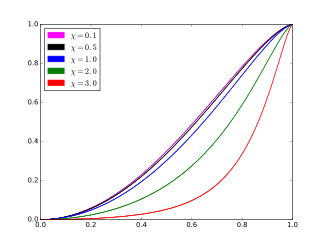In physics, the ARGUS distribution, named after the particle physics experiment ARGUS,[1] is the probability distribution of the reconstructed invariant mass of a decayed particle candidate in continuum background[clarification needed].
Cumulative distribution function
The cumulative distribution function (cdf) of the ARGUS distribution is
 .
.
Parameter estimation
Parameter c is assumed to be known (the kinematic limit of the invariant mass distribution), whereas χ can be estimated from the sample X1, …, Xn using the maximum likelihood approach. The estimator is a function of sample second moment, and is given as a solution to the non-linear equation
 .
.
The solution exists and is unique, provided that the right-hand side is greater than 0.4; the resulting estimator  is consistent and asymptotically normal.
is consistent and asymptotically normal.
Generalized ARGUS distribution
Sometimes a more general form is used to describe a more peaking-like distribution:


where Γ(·) is the gamma function, and Γ(·,·) is the upper incomplete gamma function.
Here parameters c, χ, p represent the cutoff, curvature, and power respectively.
The mode is:

The mean is:

where M(·,·,·) is the Kummer's confluent hypergeometric function.[2][circular reference]
The variance is:

p = 0.5 gives a regular ARGUS, listed above.























